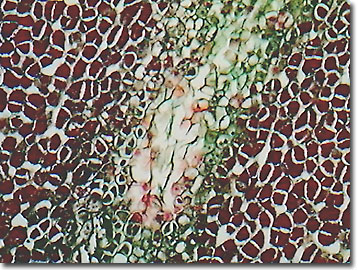Brightfield Digital Image Gallery
Pine Mature Embryo
Pine is the common name for species belonging to the genus Pinus, a member of the family Pinaceae, which represents resinous trees with needle-like leaves. Consisting of about 262 species, this is the largest family of conifers and includes fir, larch, spruce, hemlock, cedar, and Douglas fir.

Pine trees are cone-bearing evergreens found worldwide, although in the Northern Hemisphere, they occur primarily in northern temperate regions. Typically, they have woody stems covered in bark, which protects the vascular tissues and allows the conduction of nutrients and water. When harvested, pine trees provide materials such as lumber, turpentine, rosin, paper, pulp, fuel, and even food (pine nuts). Pines are gymnosperms, which are non-flowering plants that produce naked seeds, not enclosed in an ovary. In many pine species, winged seeds are distributed from cones by exposure to wind or fire, moving developing embryos far enough away from parents to eliminate potential competition for vital light, space, water, and nutrients.
Tiny pine embryos are encased within a seed coat and do not emerge until favorable growing conditions exist. The most intensely studied pine seeds today belong to the Wollemi pine (the dinosaur tree), a cone-bearing tree whose lineage dates back over 250 million years. Although these prehistoric pines were believed extinct, predating humans walking the Earth, a cluster of about 40 trees were recently discovered outside of Sydney, Australia. Another famous member of the pine family, the bristlecone, is known to have the longest life span of any tree. Often growing slowly and scraggily near timberline on the sides of tall mountains, some present day bristlecone pine trees were beginning life as seedlings in the Rocky Mountains when the great pyramids were being built in Egypt.
The familiar pinecone is actually a reproductive organ that contains either female eggs or male sperm. Once pollinated, an ovule will transform into a pine embryo enveloped by a protective seed coat. The embryo, a new sporophyte plant, and a supply of stored food from the nutritive tissue of the megagametophyte, remain dormant until the outer shell is exposed to water levels that entice germination. As food reserves are made available, a tiny root emerges and is followed by the hypocotyl part of the stem. Growth of the stem carries the seed case up out of the soil to be shed so that immature (or embryonic) leaves, called cotyledons, can expand and become photosynthetic. The young plant will continue to grow, depending upon the ability of both the shoots and roots to garner nourishment. The mature pine embryo consists of two growing points (the shoot and root apical meristem), a root cap, and seven or eight cotyledons. The embryo, enclosed within the desiccation-resistant seed coat, may remain dormant for an extended period until environmental conditions are favorable for germination and initiation of a new sporophyte generation.
Contributing Authors
Cynthia D. Kelly, Thomas J. Fellers and Michael W. Davidson - National High Magnetic Field Laboratory, 1800 East Paul Dirac Dr., The Florida State University, Tallahassee, Florida, 32310.
BACK TO THE BRIGHTFIELD IMAGE GALLERY
BACK TO THE DIGITAL IMAGE GALLERIES
Questions or comments? Send us an email.
© 1995-2022 by Michael W. Davidson and The Florida State University. All Rights Reserved. No images, graphics, software, scripts, or applets may be reproduced or used in any manner without permission from the copyright holders. Use of this website means you agree to all of the Legal Terms and Conditions set forth by the owners.
This website is maintained by our
Graphics & Web Programming Team
in collaboration with Optical Microscopy at the
National High Magnetic Field Laboratory.
Last Modification Friday, Nov 13, 2015 at 02:19 PM
Access Count Since September 17, 2002: 18211
Visit the website of our partner in introductory microscopy education:
|
|
